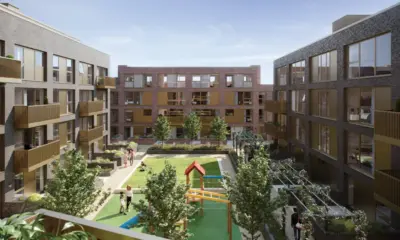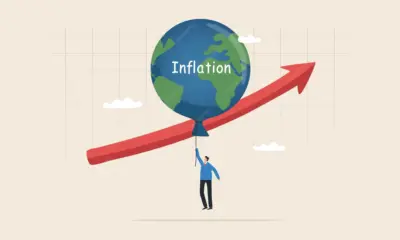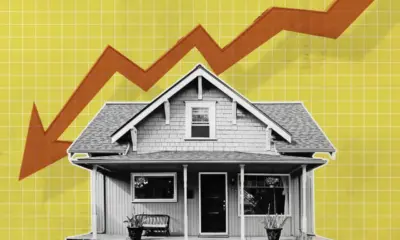Business
London House Prices Edge Lower as Mortgage Costs Bite

Introduction
London’s housing market is softening again as high mortgage costs continue to limit affordability and slow demand. After years of rapid price growth, the city is witnessing modest but persistent declines. The latest data from the Office for National Statistics shows that average property prices in London fell by about 1.4 percent in the past quarter, marking a third straight monthly drop. Estate agents report fewer viewings, longer completion times, and more sellers lowering asking prices to attract cautious buyers.
The shift reflects the cumulative impact of high borrowing costs and tighter lending standards. The combination has reduced mortgage approvals to their lowest level since 2020. Buyers are waiting for interest rate relief, while homeowners on expiring fixed-rate deals are bracing for higher repayments. Developers, too, are delaying launches and scaling back projects as sales volumes weaken.
Rising Borrowing Costs
Mortgage costs remain the dominant influence on the property market. Average two-year fixed rates hover near 5.8 percent, while five-year deals stand around 5.4 percent. Compared with the ultra-low rates of 2021, this difference adds hundreds of pounds to monthly payments for an average London home. Lenders have also become stricter, demanding higher deposits and verifying income more carefully.
The result is a sharp decline in affordability. Many first-time buyers have been priced out entirely, and even higher earners are struggling to meet loan criteria. Homeowners whose fixed-rate terms are ending face large increases in repayments. For many, refinancing at today’s rates means an extra £400 to £600 per month. This squeeze on disposable income has reduced household spending and weakened confidence across the wider economy.
Demand Weakens Across Boroughs
Buyer activity continues to fall. Surveys by the Royal Institution of Chartered Surveyors show new buyer inquiries declining for six consecutive months. Many households expect that interest rates will begin to ease in 2025, so they prefer to wait. Estate agents note that viewing volumes are roughly a third lower than a year ago.
Outer boroughs such as Croydon, Barking, and Enfield are experiencing the steepest price drops because these areas rely more heavily on mortgage-funded buyers. Central districts like Westminster and Kensington remain more stable due to cash purchases and overseas investment. South London suburbs that benefited from the remote-work boom are also cooling as hybrid work patterns normalize.
Rental Market Under Pressure
The rental sector is absorbing displaced demand. With fewer people buying, competition for rental properties has intensified. Rents across London have risen by nearly 8 percent in the past year, according to property portal data. This benefits landlords but further strains household budgets.
However, many private landlords face higher financing costs and new regulations, leading some to exit the market. As a result, rental supply remains limited even as demand increases. Institutional investors see opportunity in this environment. Build-to-rent developments have grown steadily, backed by pension funds seeking stable long-term returns.
Developers Slow New Construction
Developers are responding to the slowdown by delaying projects and revising pricing strategies. Rising material and labor costs have compounded challenges. Some builders are offering incentives such as deposit contributions and energy-efficiency upgrades to encourage sales. The slowdown in construction could exacerbate the long-term housing shortage if sustained.
Planning data indicates a fall in new housing starts across Greater London. The number of approved projects has dropped by more than 20 percent year on year. Smaller developers in particular face financing constraints, while larger firms are focusing on prime sites or rental schemes.
Economic and Policy Context
The housing market’s weakness mirrors broader economic headwinds. The Bank of England’s policy of high interest rates has cooled inflation but also restrained growth. Wage increases are slowing, while essential expenses remain high. Many households are using savings to cope with living costs, reducing their ability to build deposits for a home purchase.
Government support remains limited. The Help to Buy scheme has ended, and replacement programs have yet to gain traction. Stamp duty thresholds are under review, adding uncertainty for buyers and sellers alike. Local councils continue to face funding shortages that delay affordable housing projects. Without meaningful policy reform, analysts warn that supply shortages could persist even if demand weakens temporarily.
Investor and Market Sentiment
Investor attitudes toward London property are cautious. Domestic investors are reallocating capital toward safer assets such as bonds, which currently yield competitive returns. International investors remain selective, focusing on areas with long-term growth potential or high rental yields. Currency movements have influenced cross-border investment, with sterling volatility affecting overseas appetite.
Still, London retains appeal as a global real estate hub. Its stability, legal framework, and depth of demand continue to attract institutional funds. Sectors like build-to-rent and student accommodation are receiving renewed interest, viewed as resilient even in tighter conditions. Analysts believe these segments may underpin market stability while traditional owner-occupier demand remains subdued.
Outlook and Potential Recovery
Market forecasts suggest continued mild declines through early 2025 before stabilization later in the year. If inflation continues to moderate, the Bank of England may begin to reduce rates gradually, easing pressure on mortgage borrowers. Lower financing costs could lift confidence and spur limited price recovery, particularly in mid-range properties.
However, the scale of any rebound will depend on wage growth, employment trends, and overall economic momentum. Analysts expect that prices will remain below 2023 peaks for several quarters. A strong recovery seems unlikely until affordability metrics improve substantially.
Conclusion
London’s housing market is navigating a necessary adjustment after years of rapid appreciation. High borrowing costs have curbed speculative activity and shifted the focus toward affordability. Price declines across much of the capital represent a rebalancing rather than a collapse.
For policymakers, the challenge is to support housing accessibility without reigniting inflation. Coordinated measures across monetary, fiscal, and planning frameworks will be needed to sustain long-term stability. Developers and investors must adapt to a market that values affordability, sustainability, and rental demand over short-term price gains.
While short-term prospects remain subdued, London’s fundamentals remain strong. Population growth, international appeal, and limited land supply ensure continued underlying demand. Once borrowing costs ease and confidence returns, the city’s housing market is likely to recover gradually on a more sustainable path. The current downturn may ultimately serve as a reset, creating conditions for a healthier balance between buyers, sellers, and investors in the years ahead.




















